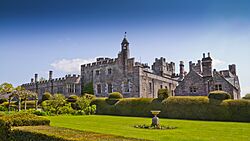Hutton in the Forest facts for kids
Quick facts for kids Hutton in the Forest |
|
|---|---|
 |
|
| General information | |
| Town or city | Cumbria |
| Country | England |
Hutton in the Forest is a beautiful country house in Cumbria, England, near the village of Skelton. It is a Grade I listed building, which means it's considered very important to the nation's history and must be protected. For over 300 years, it was home to the Fletcher-Vane family. Today, their relatives, the Barons Inglewood, own and care for the house.
The house is like a history book made of stone and wood. It started as a strong medieval fortress and has been changed and added to by every family that lived there. This means you can see many different styles of design, from the 1600s all the way to modern times.
Contents
A House Built Through Time
Hutton in the Forest wasn't built all at once. It grew over many centuries as different owners added new parts to make it their own.
From Fortress to Family Home
The oldest part of the house is a pele tower. This was a tall, strong stone tower built long ago for protection during dangerous times. Over the years, as life became safer, families added more comfortable rooms and wings to the tower.
Each new generation left its mark. The outside and inside of the house show a mix of styles. It's a fascinating puzzle of architecture from different periods.
Exploring the Inside
Stepping inside Hutton in the Forest is like walking through different moments in history. Each room has its own story and style.
Famous Rooms and Features
- The Gallery: Built in the 1630s, this long room is a rare feature for a house in the north of England. It is filled with old furniture and paintings of people who once lived here.
- The Hall: This grand room was built around 1680. Its most famous feature is the Cupid Staircase, a beautiful wooden staircase decorated with carvings.
- 18th-Century Rooms: The Cupid Staircase leads up to a set of rooms decorated in the mid-1700s. One of these is called the Cupid Room.
- Later Additions: The house continued to change. The drawing room was added around 1830, and a library was created in 1870. There is also a room decorated in the Arts and Crafts style, which was popular in the late 1800s and early 1900s.
Gardens and Grounds
The beauty of Hutton in the Forest extends outside to its gardens and woodlands.
The Walled Garden and Terraces
A lovely Walled Garden was built in the 1730s. It protects a large collection of flowers and plants from the wind. The house also has terraces, which are like giant stone steps in the garden, that were first created in the 1600s.
Woodland Walk and Dovecote
You can take a walk through the woods on the property. Here you can find a stone dovecote from the 17th century. A dovecote was a building used to keep pigeons or doves for their eggs and meat. This one is special because it still has its potence, a spinning ladder inside that helped people collect the eggs from the nests.
The grounds also feature an arboretum, which is like a library for trees. The 1st Lord Inglewood planted many new types of trees, and today you can see over 70 different species.
St James' Church
In a field near the house stands the small church of St James. Records show a church has been here since at least 1291. The famous architect Anthony Salvin did a lot of work to restore it during the Victorian era. Inside, you can see a piece of an ancient Norman Cross and many memorials to the Fletcher and Vane families, showing how important they were to this area for centuries.
See also
- Grade I listed buildings in Cumbria
- Listed buildings in Skelton, Cumbria

